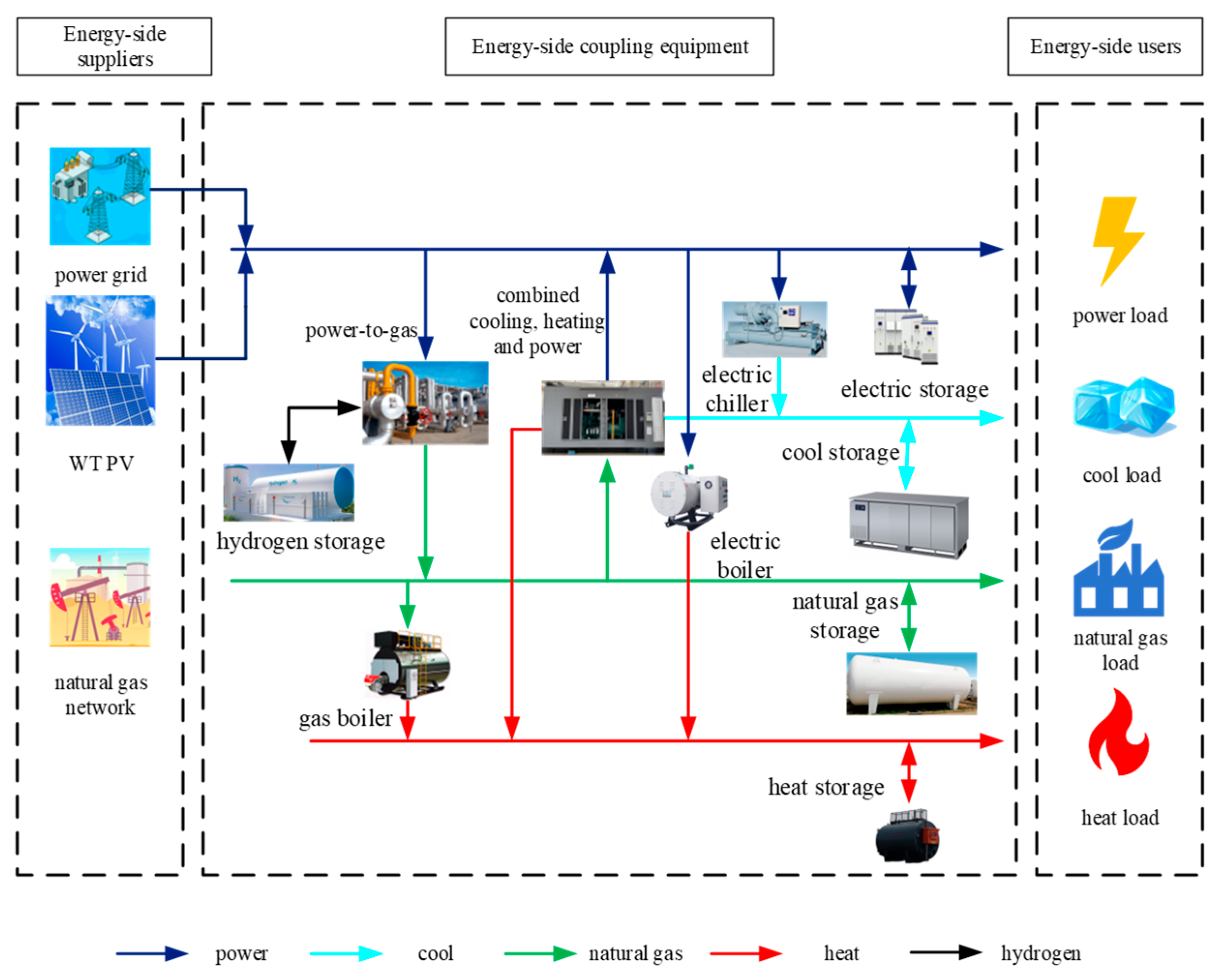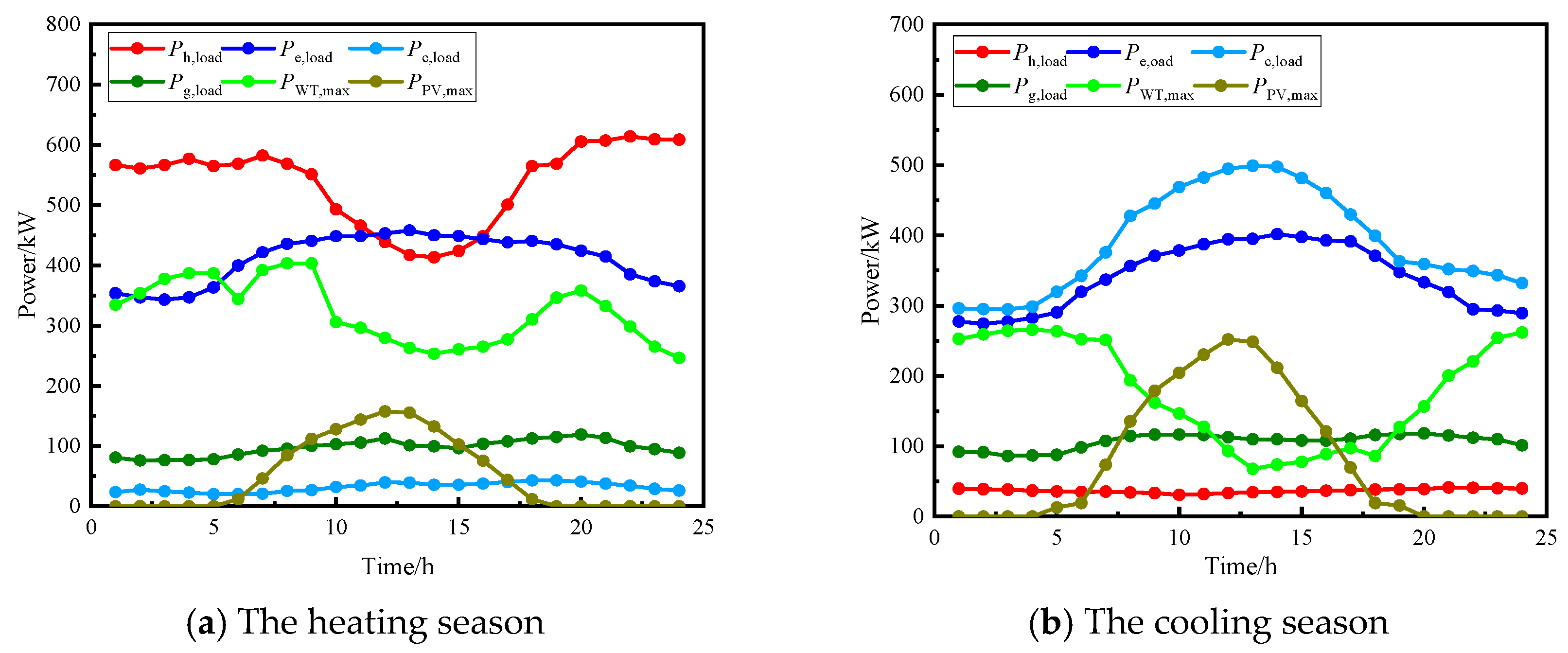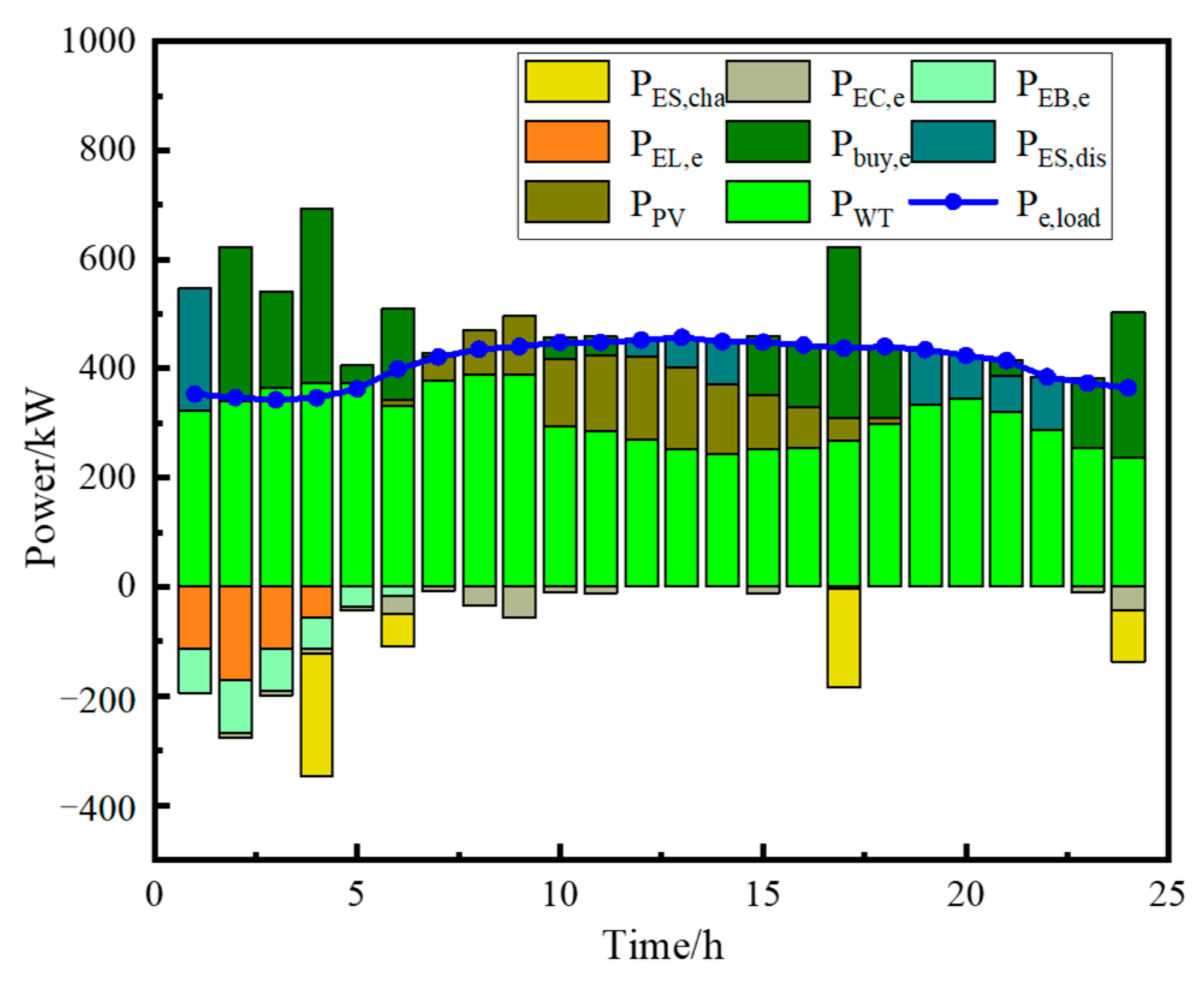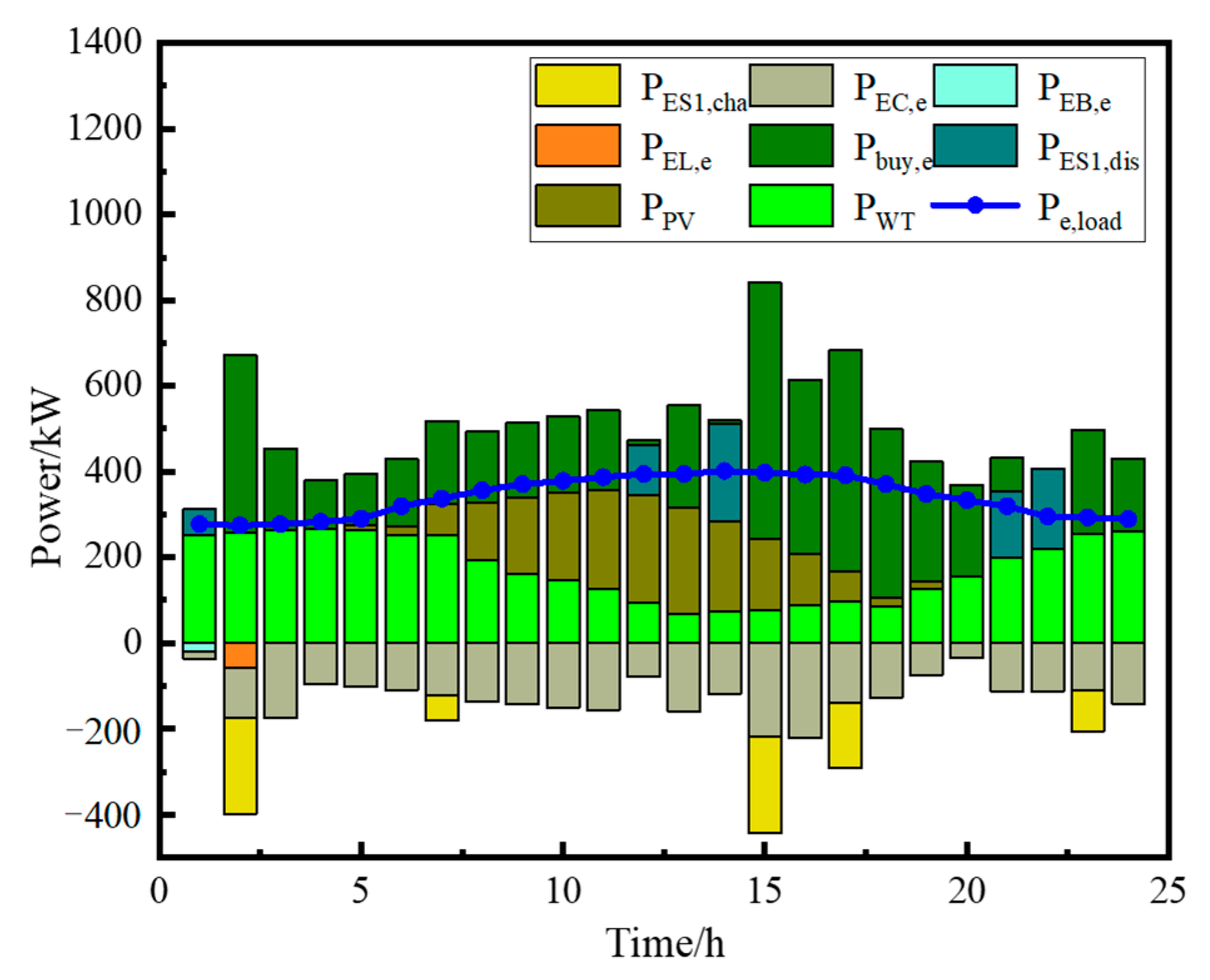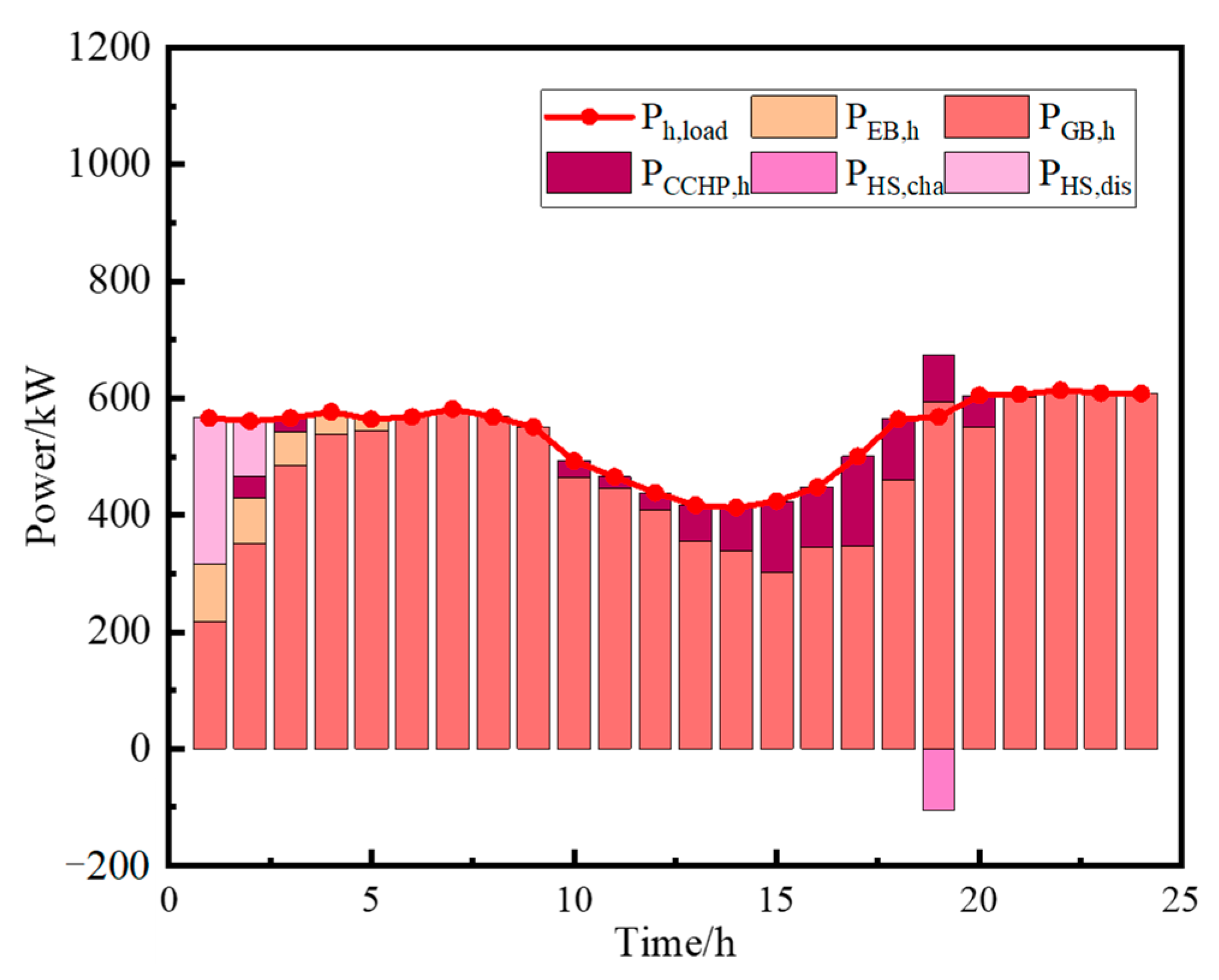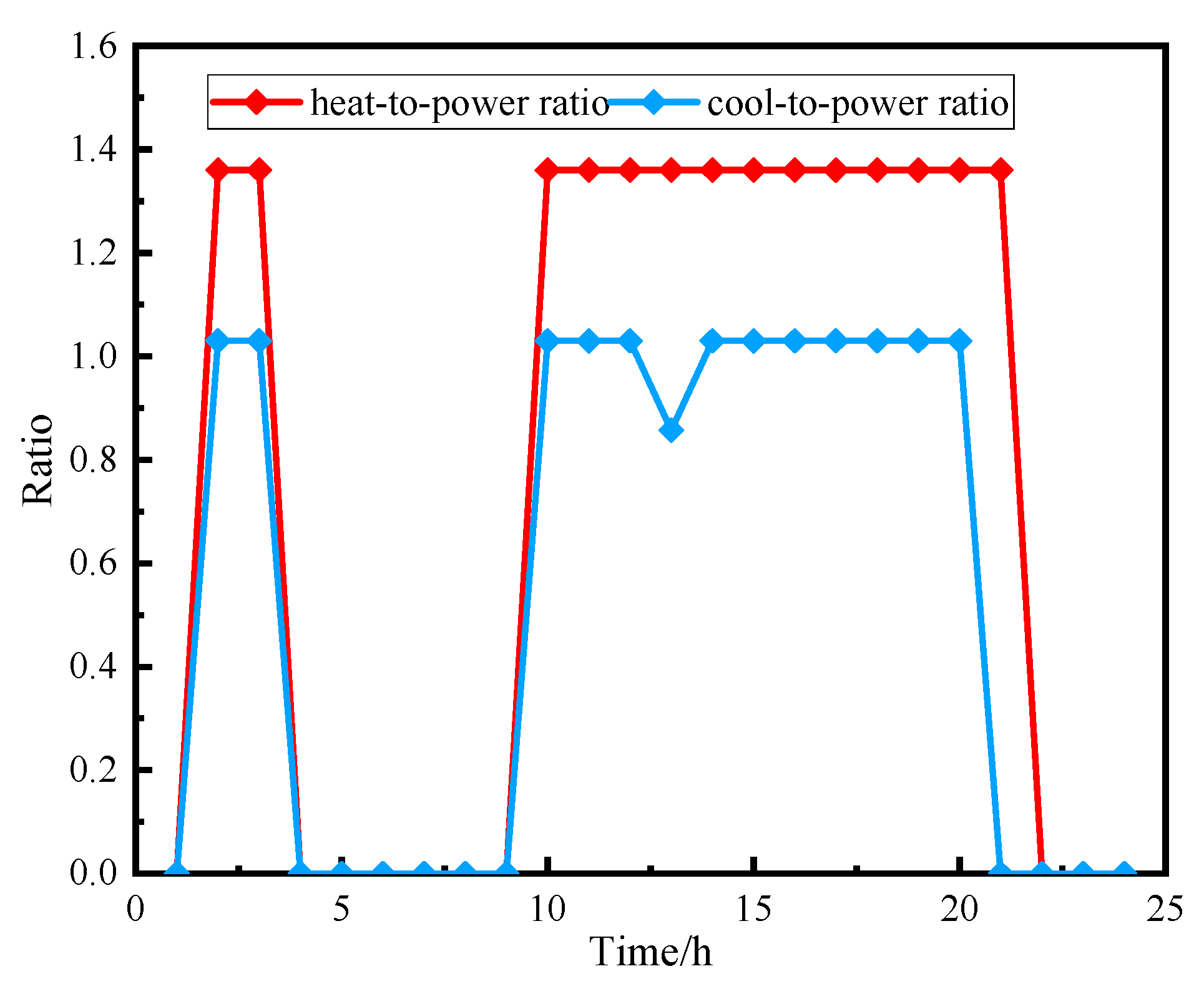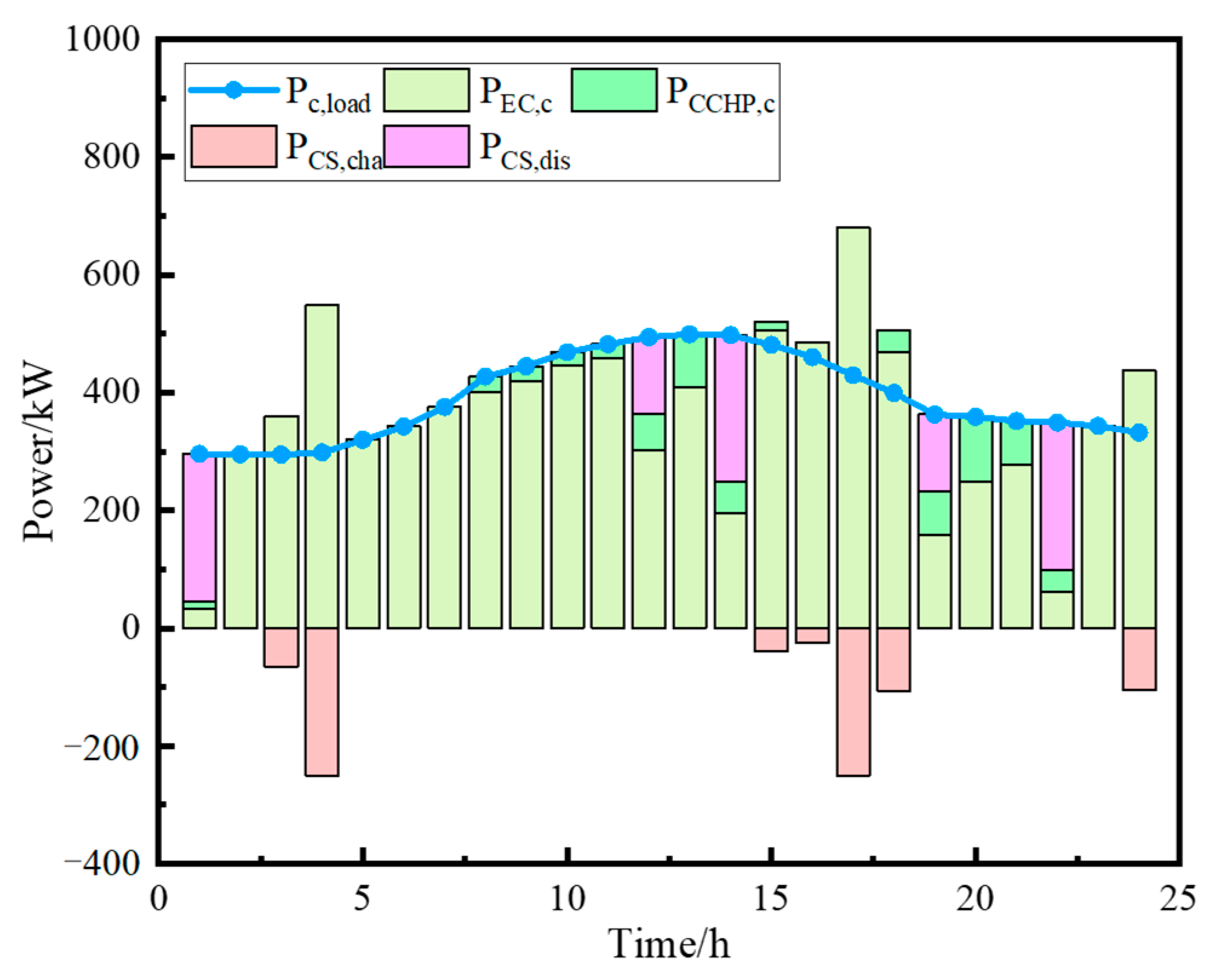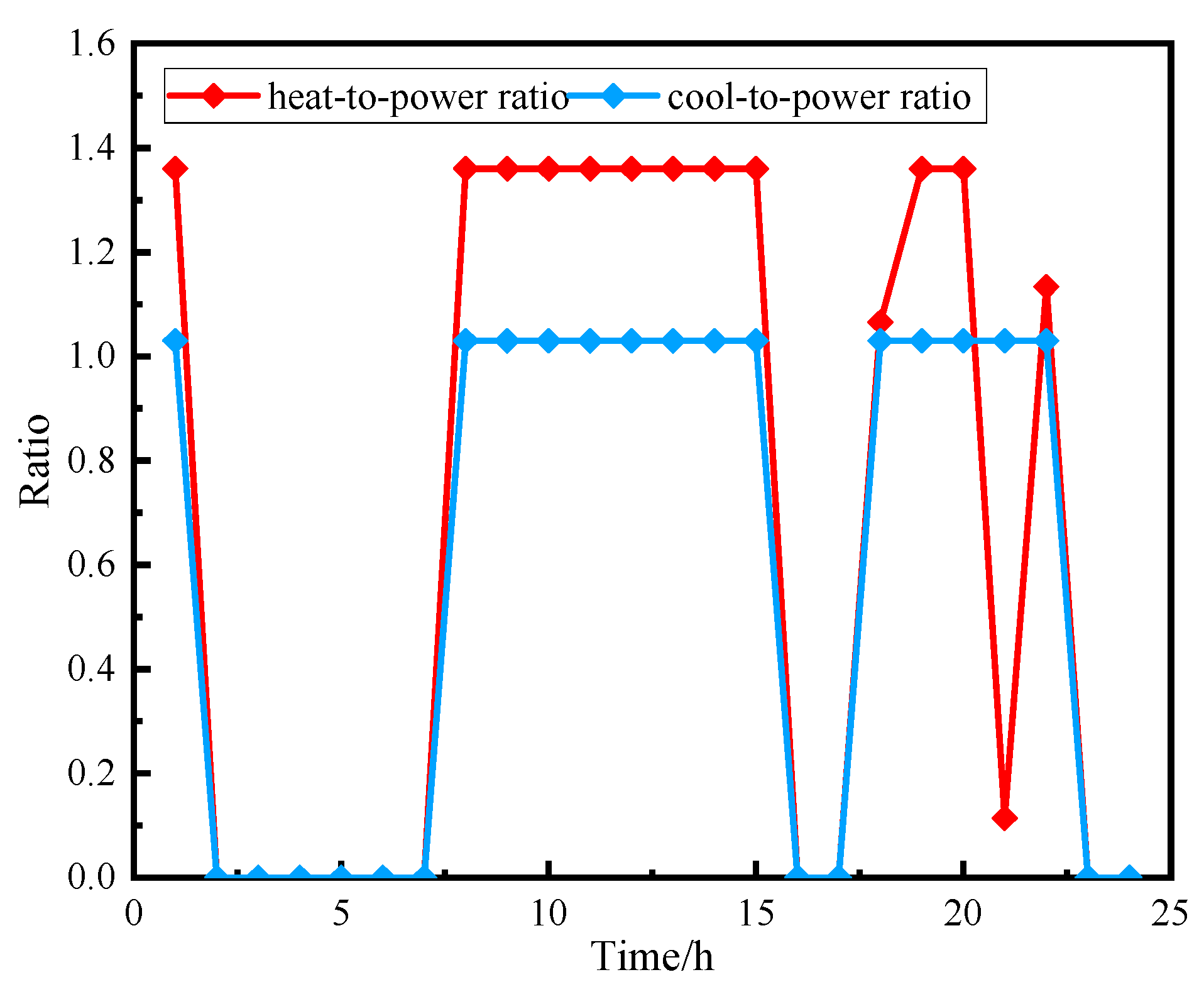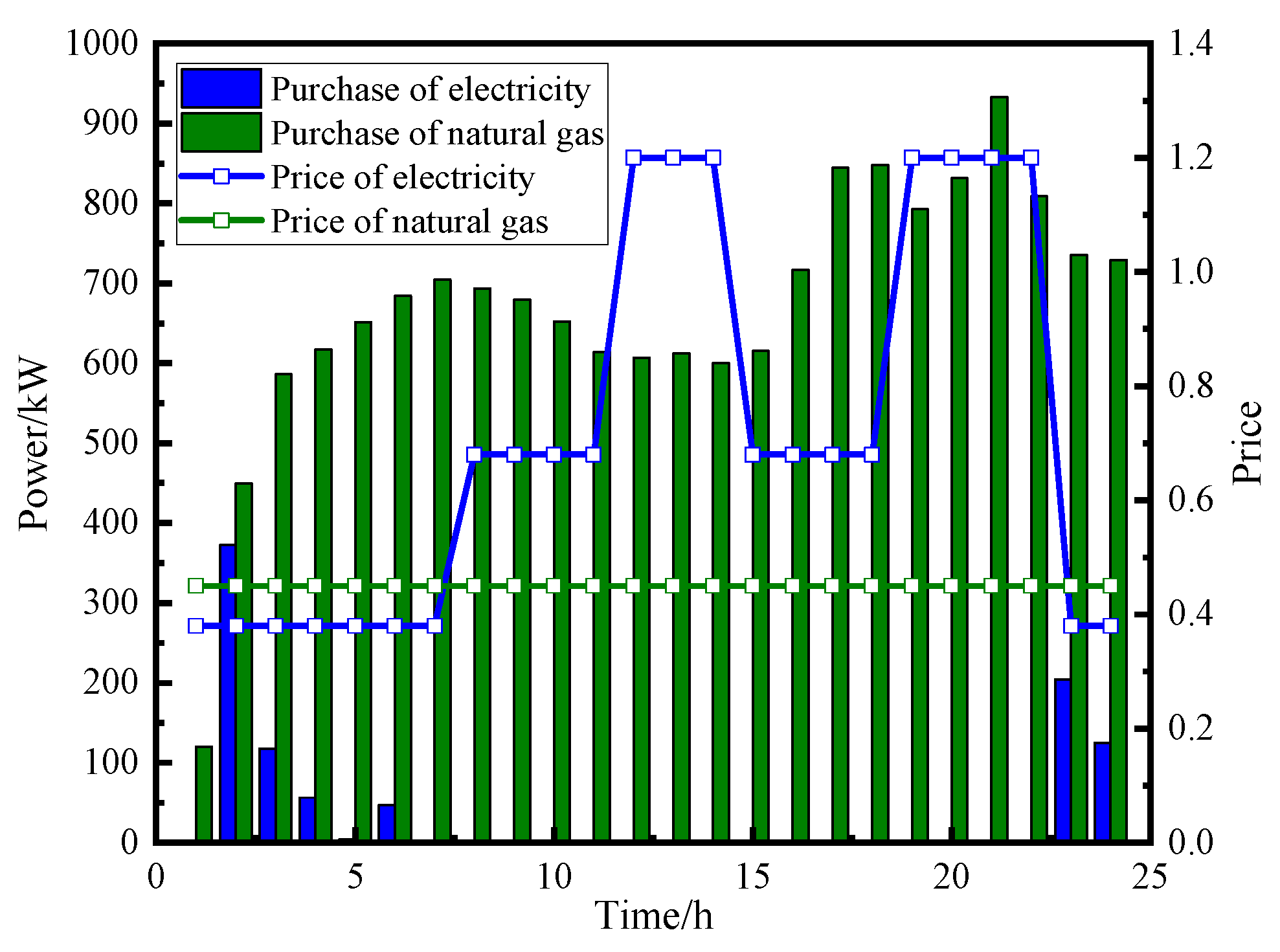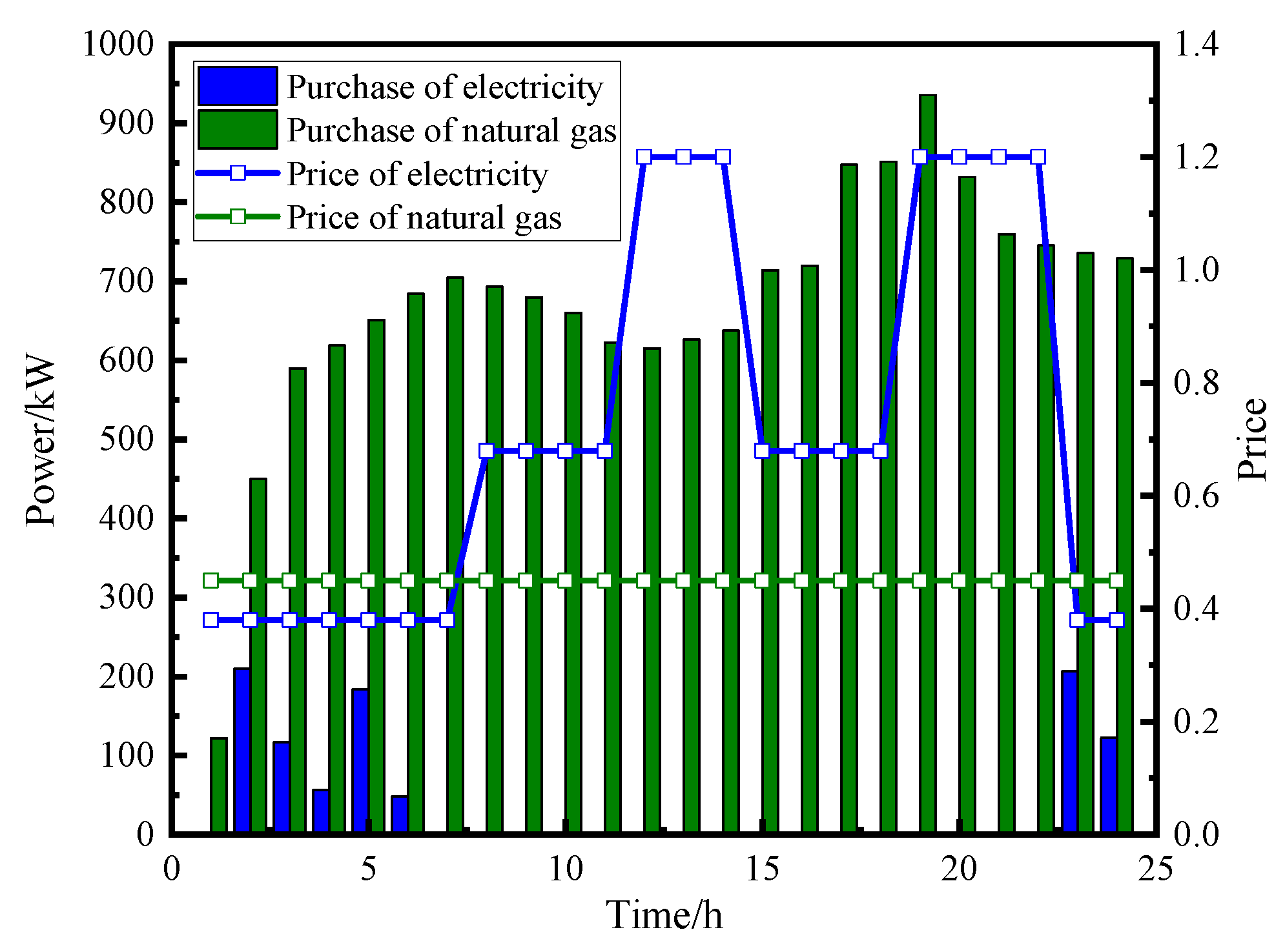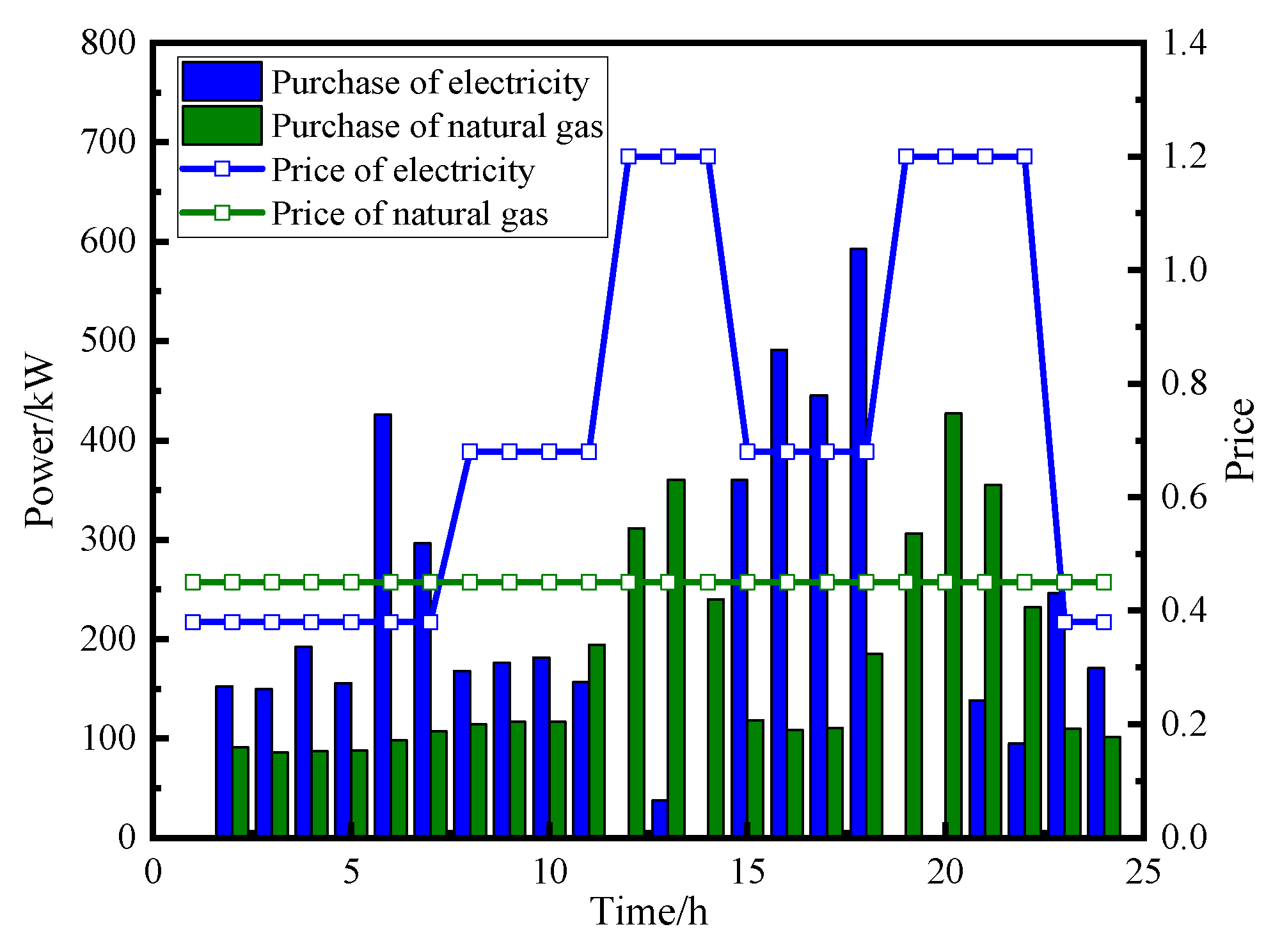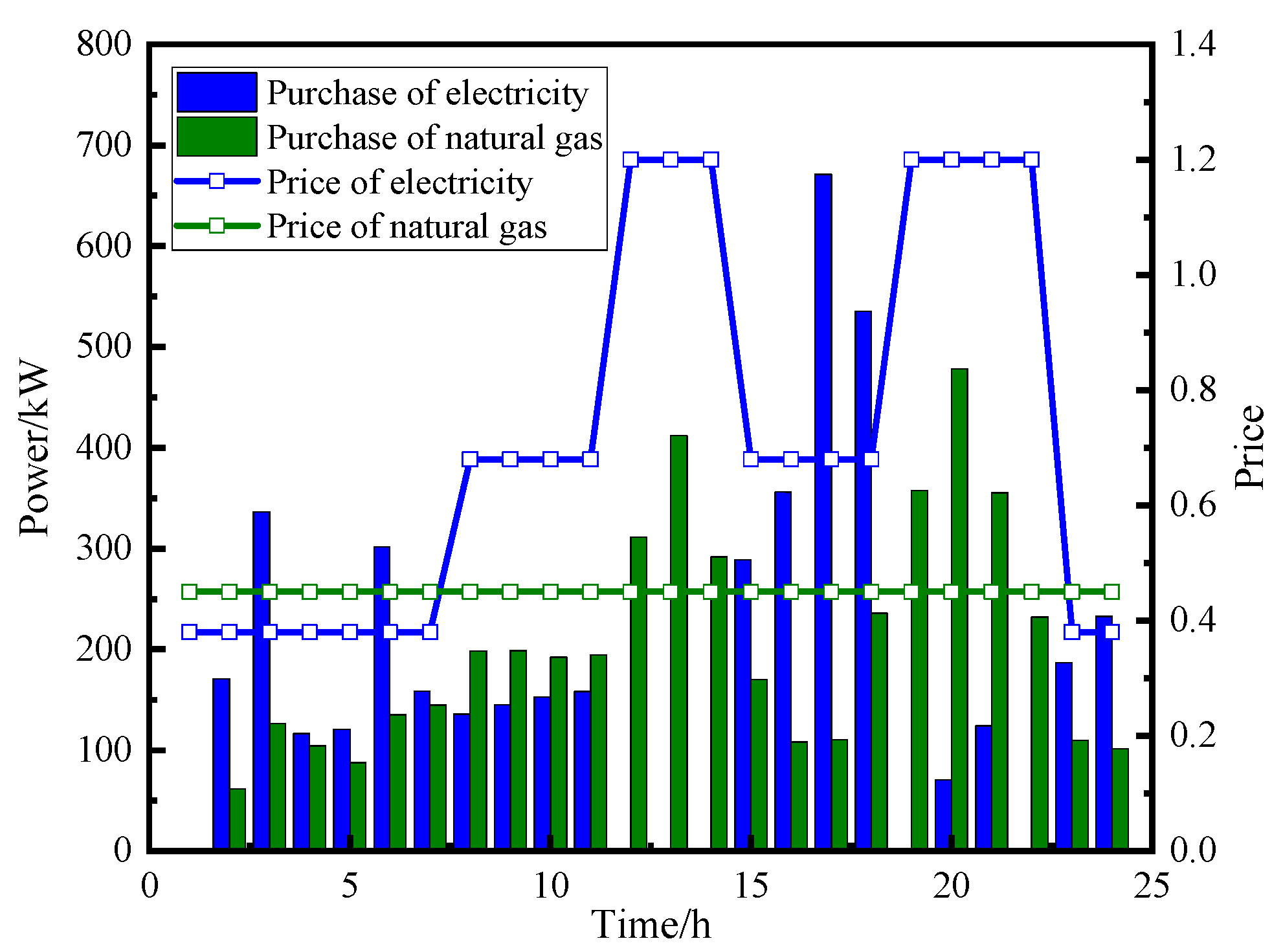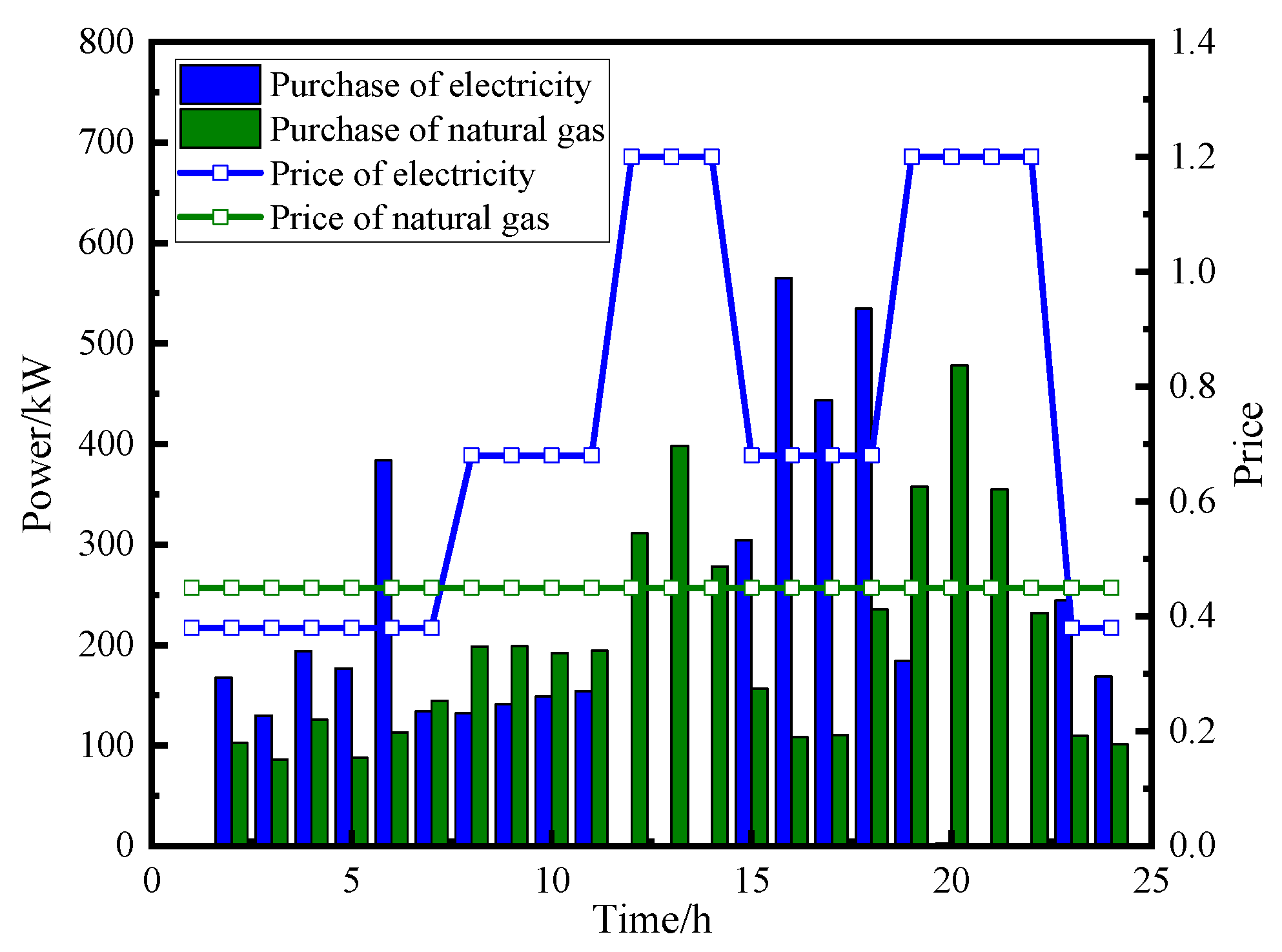1. Introduction
The escalating global demand for electricity has accelerated the depletion of finite fossil fuel reserves and exacerbated environmental degradation [
1,
2,
3], necessitating urgent exploration of sustainable energy alternatives. Advances in generation technologies have driven the widespread adoption of renewable energy systems worldwide, particularly wind and solar photovoltaic power, owing to their environmental benefits and wide availability. However, traditional power systems are generally designed to supply only a single type of energy load, making it difficult to leverage the complementary characteristics of different energy sources. Integrated energy systems (IESs) have been widely used due to their advantages of coupling multiple energy sources, such as power, heat, natural gas, and achieving interaction between different energy systems [
4,
5,
6]. Meanwhile, IESs are typically categorized by scale into urban, park, and end-user systems. Park integrated energy systems (PIESs) are specifically designed for micro-energy networks in high-energy-density applications such as industrial parks, data centers, and residential communities. The effective coordination and optimal dispatch of multi-energy systems within parks can significantly enhance the operational efficiency, economic performance, and environmental sustainability of PIESs. Given these benefits, research on PIES optimization has become a crucial focus in energy management, with important implications for developing intelligent, low-carbon, and high-efficiency energy systems [
7,
8,
9].
With the growth of IESs, the patterns of energy supply and demand have undergone significant changes, revealing distinct operational features. Therefore, the coupling between different energy sources and the inherent uncertainty of renewable energy are important guarantees for the safe and steady functioning of IES. Wang et al. in [
10] developed a new IES multi-objective optimization model integrating electricity, heating, and cooling, and the NSGA-II was adopted to obtain the best operational strategy for IESs. However, the limited number of devices included in their IESs may restrict compatibility with broader energy technologies. Existing research has explored various optimization approaches for IES. Jiang et al. in [
11] formulated a coordinated gas–electric distribution system model employing a two-stage optimization framework to solve the associated mixed-integer nonlinear programming problem. Li et al. in [
12] proposed a combined cooling, heating, and power (CCHP) system integrated with hydrogen storage, simultaneously minimizing operational costs and carbon emissions while enhancing wind power integration. In [
13], Wang et al. developed an IES framework incorporating power-to-gas (P2G) and combined heat and power (CHP) technologies, and the alternating direction method of multipliers was used to obtain the optimal results. In [
14], Perrone et al. proposed a model for a biomass-based renewable energy CCHP mode to minimize the cost, which did not involve carbon emissions. In [
15], Su et al. introduced a reliability analysis approach for power supplies in complex industrial automation systems to enhance safety and efficiency. However, this technique only addressed thermoelectric coupling without modeling the thermal–electrical conversion process. In [
16], Jia et al. proposed a tri-objective optimization framework for regional IES incorporating economic, environmental, and reliability considerations. To address uncertainties in energy supply and demand, Chen et al. [
17] developed a low-carbon economic dispatch model for IES, integrating P2G, CHP, and carbon capture and storage (CCS) technologies. In [
18], Liu et al. explored the economic, environmental, and thermal comfort implications of sizing a multi-energy IES considering uncertainties. Most existing studies use CHP or CCHP equipment in a simple way and only consider fixed heat-to-power and cold-to-power ratios, which limit the flexibility and efficiency of operation.
The inherent energy coupling in IES presents both opportunities and challenges. Improper coordination may result in significant efficiency losses and increased operational costs, underscoring the critical importance of developing accurate multi-energy coupling models for IES optimization [
19]. Addressing this challenge, Yan et al. in [
20] developed a renewable-dominant multi-energy coupling framework incorporating gas boilers (GB), electric boilers (EB), P2G, and dual energy storage systems (electrical and thermal), demonstrating enhanced renewable energy utilization rates. Huang et al. in [
21] designed a reduced-order transfer function model combined with electric-driven compressors for precise and efficient analysis of integrated electricity–gas systems. Zhang et al. in [
22] investigated the water–electricity–gas coupling process in P2G and proposed a multi-energy coupled regional IES incorporating P2G. Ma et al. in [
23] proposed an optimal dispatching model for IES that integrates CHP, P2G, and CCS, analyzing the coupling characteristics among electricity, heat, natural gas, and carbon. Zhu et al. in [
24] proposed a hybrid energy system coupling solar, wind, and hydrogen and optimized the system using NSGA-II and MOPSO. Li et al. in [
25] proposed a CCHP-containing IES for wind energy integration that achieved low operating costs. Chen et al. in [
26] employed a biomass energy combined heat and power system to modify the heat-to-electricity ratio, thus lowering the operational expenses of the rural IES and enhancing the clean energy utilization rate. Wang et al. in [
27] developed a system that integrates CCHP with ground source heat pumps. The adjustment of the ratios of cooling, heating, and electricity greatly diminished primary energy usage in the integrated energy system. The aforementioned research confirmed the substantial impact of CCHP and the strategy of adjusting the ratio of heat, cold, and electricity in decreasing the operational expenses of the IES and enhancing the utilization rate of renewable energy. Nevertheless, there exists a limited number of studies examining their contribution to the reduction in carbon emissions.
With the continuous improvement of the carbon trading market, carbon emissions trading (CET) and green certificate trading (GCT) are two trading mechanisms that are widely employed in PIES. Liu et al. in [
28] developed a multi-region IES dispatch model that considered the CET and GCT mechanisms to reduce the IES operating cost. Yuan et al. in [
29] formulated a low-carbon economic dispatch model for PIES that integrates carbon capture technology and a laddered carbon trading mechanism (LCTM), demonstrating significant reductions in both operational costs and emissions. Building upon this framework, Wei et al. in [
30] introduced a three-stage investment planning model for PIES equipment under LCTM, revealing that system emissions are highly sensitive to baseline carbon prices but show limited variation with changes in price interval duration. Further advancing this research direction, Zhang et al. in [
31] implemented a two-stage optimization approach for hybrid renewable systems utilizing a reward–penalty LCT strategy. Complementing these works, Wang et al. in [
32] proposed a robust planning methodology for regional IES that accounts for carbon price uncertainty to improve emission reduction potential. Zhao et al. in [
33] developed a PIES model incorporating P2G and CCS, as well as using an optimization strategy with scenario analysis, but they did not consider renewable energy and load uncertainties. Sun et al. in [
34] proposed an ideal PIES dispatching model that takes into account variable loads and P2G using the seasonal LCTM (SLCTM), which improved both system flexibility and overall efficiency. While the studies above successfully implemented LCTM, they offered limited consideration of the impact of seasonal conditions on operational dispatching outcomes. In addition, the integration of CCHP equipment with LCTM remains underexplored.
To improve the economics of PIES, Li et al. in [
35] developed an IES model integrating CHP, CCS, and P2G and proposed a multi-objective optimization method based on compromise planning to obtain the optimal solution in terms of environment and economy. Alizad et al. in [
36] used a stochastic dynamic programing approach to optimize the design of a P2G integrated energy system, the investment costs and operating costs of the system were reduced. Guo et al. in [
37] developed a nonlinear co-optimization model for regional IES with multi-regional energy sharing and storage. They proposed a two-level co-optimization method to obtain a more economical solution. Li et al. in [
38] proposed a Stackelberg game optimization framework and methodology for balancing the interests of energy operators and consumers to reduce the cost for energy consumers. Meng et al. in [
39] developed a two-level game optimal dispatching model based on the demand response model and the LCTM model of user experience, and the user satisfaction, the economy, and the low carbon of IES operation were improved. Tan et al. in [
40] proposed a coordinated operation strategy for multi-regional IES that considered market participation. This strategy favors the economy and environmental friendliness of multi-regional IES. To reduce cost and carbon emission, Lyu et al. in [
41] proposed a price-based integrated model for low-carbon economic dispatch of thermoelectric demand response and vehicle grid integration. Li et al. in [
42] proposed a bi-level closed-loop framework integrating consumer and market interactions, employing NSGA-II to optimize system economics. These studies have demonstrated the significant effectiveness of LCTM in improving the economic feasibility and environmental sustainability of PIES. However, existing methods mainly rely on LCTM and energy conversion equipment for low-carbon economic dispatch without fully integrating them with other operational dispatch strategies.
The ability of CHP and CCHP to adjust the thermoelectric ratio provides a new solution for the energy transition and contributes to the improvement of global energy efficiency. Hajabdollahi et al. in [
43] investigated an IES with CCHP; the annual variable electric cooling ratio strategy and particle swarm algorithm were employed for optimization and solution. Wang et al. in [
44] conducted a comparative energy flow analysis between CCHP and separated production systems, demonstrating that CCHP systems can adaptively track both electrical and thermal loads across multiple operational modes. In a complementary study targeting emission reduction, Su et al. in [
45] employed a carbon footprint methodology to quantify emissions from diverse generation assets and developed an adjustable thermoelectric ratio CHP model to enhance the low-carbon performance of IES. Zhang et al. in [
46] constructed a CHP system containing an absorption heat pump and concluded that operating at 100% turbine heat acceptance load with a thermoelectric ratio of 100% reduced the coal consumption rate while increasing the power output. The aforementioned literature predominantly considers either the thermal-to-electricity ratio or the cold-to-electricity ratio in isolation, with relatively few studies simultaneously examining the adjustable cool–heat–power ratio strategy while accounting for both thermal and electrical energy.
In IES, the use of P2G and CCS can reduce carbon emissions and enhance the efficiency of renewable energy. The implementation of the variable electric cooling ratio strategy and adjustable thermoelectric ratio strategy is effective, but it has not addressed the relationship between thermal, cool, and electrical energy. To overcome these limitations, in this work, a seasonal PIES based on the adjustable cool–heat–power ratio (SPIESchpr) is proposed. This strategy facilitates dynamic multi-energy coordination, significantly improving energy utilization in PIES compared to conventional approaches. In SPIESchpr, equipment models containing photovoltaic (PV), wind turbine (WT), CCHP, and P2G are developed. The equipment output constraints, the unique charging and discharging state constraints of the energy storage, the constraints of equal initial and end capacities of the energy storage, and the constraints of the overall system’s electric, heat, cold, and natural gas balances are set. The energy purchase cost (EPC), energy abandonment cost (EAC), and CTC are also taken as objective functions. A novel adjustable cool–heat–power ratio (Achpr) strategy is introduced to enhance natural gas utilization efficiency through optimal waste heat allocation between heating and cooling demands. Comparative analysis against conventional constant ratio (Cchpr) approaches confirms its superior performance. The synergistic integration of P2G with CCHP enables effective conversion and storage of surplus renewable generation, simultaneously improving energy utilization efficiency and economic performance. Furthermore, the implementation of an SLCTM demonstrates considerable emission reduction potential, validated through three comparative scenarios. The LCTM, the proposed strategy, significantly enhances the low-carbon operational performance of PIES and supports flexible seasonal adaptation throughout the year. By dynamically allocating waste heat between heating and cooling applications, the strategy maximizes natural gas utilization efficiency.
The rest of the work is organized as follows.
Section 2 describes the overall framework of the SPIESchpr, developing the mathematical model of the SPIESchpr, the Achpr strategy, and the SLCTM.
Section 3 develops the SPIESchpr low-carbon economic dispatch model and sets constraints.
Section 4 discusses the impact of different carbon trading mechanisms and different strategies on the system through a case study. Finally, in
Section 5, the conclusions of this study are described.
2. Description of the SPIESchpr
In the proposed SPIESchpr, the deep coupling of electric, heat, cold, hydrogen, and natural gas energy sources is included. The mathematical model of the SPIESchpr, the Achpr strategy, and the SLCTM are described in detail in this section.
2.1. The SPIESchpr Framework
In this paper, the SPIESchpr utilizes multiple energy sources, including electricity, heat, cooling, natural gas, and hydrogen, as shown in
Figure 1. From
Figure 1, the power demand of PIES is met by a combination of PV, WT, power grid purchasing electricity, CCHP, and electricity storage (ES). To maximize the use of renewable energy, the EB, EC, and energy storage prioritize electricity generated from PV and WT. When renewable generation is high, excess power from PV and WT is converted to hydrogen and stored using a P2G system. This hydrogen can subsequently be converted into natural gas to meet demand when the natural gas supply is insufficient. During periods of low renewable energy generation, the P2G system is inactive, and the system relies on CCHP, grid electricity purchases, and discharges from energy storage to meet demand.
The proposed SPIESchpr system integrates multiple energy sources and storage devices to ensure a reliable natural gas supply. The natural gas is sourced from both the external grid and the P2G system. Within this framework, the design of GB, CCHP unit, and gas storage (GS) systems prioritizes natural gas generated from P2G. When P2G production is insufficient, supplementary natural gas is procured from the grid, while the GS discharges stored energy to meet demand.
The heating subsystem consists of GB, CCHP, EB, and HS units, which operate in synergy to balance supply and demand. During periods of heat surplus, excess thermal energy is stored in the HS. Conversely, the HS discharges heat to compensate for shortages. The system dynamically adjusts heat production based on renewable energy availability. When solar and wind generation are high, the EB serves as the primary heat source, supplemented by the GB and CCHP. When the amount of renewable energy generation is low, the GB and CCHP become the main heat sources, and the EB offers auxiliary support.
The cooling subsystem employs the EC, CCHP, and cool storage (CS) to meet cold requirements. The EC and CCHP collectively supply the required cooling load, with surplus cooling energy stored in the CS. When the cooling supply is insufficient, the CS discharges to compensate for the deficit. Owing to its higher coefficient of performance, the EC operates as the primary cooling provider, while the CCHP and charge/discharge cycles of the CS provide supplementary support.
2.2. The SPIESchpr Modeling
2.2.1. EC Modeling
The EC units utilize electric power to drive compressors within a refrigeration cycle, Using the phase transition process, the refrigerant absorbs heat in the evaporator and releases heat in the condenser to create a low-temperature environment. This method not only avoids the pollution issues associated with traditional coal-fired refrigeration but also supports the transition to low carbon by integrating with renewable energy. The cooling power output
PEC,c of the EC is defined as follows.
where
PEC,e is the power consumed;
is the electric chiller coefficient of performance, indicating the energy conversion efficiency of the EC; and
PEC,e,max is the maximum input power of the EC.
2.2.2. EB Modeling
The EB units convert electrical energy directly into thermal energy through electrically driven heating elements, utilizing water or other media to absorb and distribute the heat. Their core operation relies on efficient and precise thermal output by clean energy sources, significantly reducing carbon emissions and particulate pollution. EB offers a flexible and reliable heat supply due to its rapid response and intelligent temperature control capabilities. When wind and solar generation are abundant, they absorb renewable energy, thereby minimizing wind and solar power curtailment. The heat power output
PEB,h of the EB is defined as follows.
where
PEB,e and
are the power consumed and heating efficiency, respectively, and
PEB,e,max is the maximum input power of the EB.
2.2.3. P2G Modeling
In the PIES, the P2G system consists of an electrolytic cell (EL) and a methane reactor (MR). The EL uses electrical energy to split water into hydrogen and oxygen. Then, hydrogen and carbon dioxide react in the MR to produce natural gas. Due to the variability of renewable energy, such as solar and wind, the P2G helps maximize their utilization while minimizing carbon emissions in the PIES. The chemical equation is described by (3).
When wind and solar energy are abundant, the EL uses excess power from wind and photovoltaic to break down water into hydrogen and oxygen, which is stored in a hydrogen storage facility. Consequently, the hydrogen power output
PEL,H of the EL is defined as follows.
where
PEL,e and
are the power of consuming power and conversion efficiency of EL, respectively, and
PEL,e,max is the maximum input power of the EL.
The MR uses a chemical reaction between carbon dioxide and hydrogen to produce natural gas and water, which can either be stored or supplied directly to natural gas-consuming equipment. When natural gas is insufficient, the hydrogen storage facility releases hydrogen and outputs natural gas through the MR facility, reducing the cost of purchasing natural gas for the system. The model of the MR is shown in (5).
where
PMR,g,
PMR,H, and
are the output of natural gas power, the power of consuming hydrogen, and conversion efficiency of MR, respectively, and
PMR,H,max is the maximum input power of the MR.
2.2.4. GB Modeling
The GB uses natural gas as a fuel for heating. Natural gas is combusted in the boiler’s combustion chamber, and the heat generated is transferred from the hot gases and flames to the boiler’s heat exchanger. The heat exchanger transfers the heat to water to form hot water or steam to provide heat. Assuming the GB as an idealized model, considering only input gas power and output thermal power,
PGB,h of the GB is defined as follows.
where
PGB,g and
are the input natural gas power and thermal efficiency, respectively, and
PGB,g,max is the maximum input power of the GB.
2.2.5. Energy Storage Modeling
Energy storage devices can store energy when the system has sufficient energy and release energy to replenish it when the energy is insufficient. Therefore, the energy storage device can balance the peaks and valleys of the energy consumed by the system and improve the reliability of the system [
47]. The calculation of the energy storage system is defined as follows.
where
Pi,cha(
t) and
ηi,cha are the charging power and the charging efficiency of energy storage device
i at moment
t;
Pi,dis(
t) and
ηi,dis are the discharging power and the discharging efficiency of energy storage device
i at moment
t;
Ei(
t) and
Ei(
t + 1) are the capacities of energy storage device
i at moments
t and
t + 1; a positive value of
Pi(
t) indicates that energy storage device
i is charging at moment
t; and a negative value of
Pi(
t) indicates that energy storage device
i is in a discharged state at moment
t. Among them,
i contains ES, HS, CS, GS, and hydrogen storage tank.
2.3. The Achpr Strategy
The Achpr strategy is designed to maximize energy efficiency by adjusting the proportion of waste heat generated by the CCHP. During the heating season, the majority of waste heat is directed toward heating to meet heat load demand and, at this time, the heat-to-power ratio is usually at its maximum. Conversely, during the cooling season, most waste heat is allocated for cooling to supply the cool load, with the cool-to-power ratio reaching its maximum. Compared to the constant cool–heat–power ratio strategy used in existing studies, the proposed Achpr demonstrates greater improved adaptability to seasonal variations and enables dynamic adjustment of waste heat utilization. This significantly enhances the energy utilization efficiency of PIES while reducing carbon emissions.
The CCHP system implemented in PIES integrates three core components, a gas turbine (GT), a waste heat boiler (WHB), and an absorption chiller (AC), forming a comprehensive solution that simultaneously generates power, heating, and cooling. The thermodynamic process initiates with GT combustion, where high-temperature, high-pressure gases drive turbine rotation, converting the chemical energy of natural gas into mechanical energy, which is then transformed into electricity. Waste heat recovered from the exhaust gases is utilized by the WHB to provide space heating and is also supplied to the AC to produce cooling energy. The complete system modeling framework incorporates these energy conversion processes as follows.
where
PCCHP,g is the power of natural gas consumed;
PCCHP,g,max is the maximum input natural gas of the CCHP;
is the power generation efficiency;
PCCHP,e,
PCCHP,h, and
PCCHP,c are power, heat, and cool energy output from CCHP, respectively; and
ε and
δ are the heat-to-power ratio and the cool-to-power ratio. The heat-to-power ratio is the ratio of heat to electrical energy output from the CCHP and the cool-to-power ratio is the ratio of cool to electrical energy output from the CCHP.
2.4. The SLCTM
In the PIES, the carbon trading mechanism plays a crucial role in addressing climate change and reducing greenhouse gas emissions. Carbon quotas can be traded by the park in the carbon trading market. When the park has surplus quotas, it can sell them and, if the quota is insufficient to meet carbon emission needs, it must purchase additional quotas. This mechanism, which includes free carbon quotas, actual carbon emissions, and carbon transaction costs, helps drive energy conservation and emissions reduction efforts within enterprises.
2.4.1. Seasonal Free Carbon Allowance Model
Unlike conventional carbon trading approaches, the SLCTM represents a climate-adaptive policy instrument designed to address seasonal variations in energy demand. By dynamically adjusting carbon allowances across different seasons, the SLCTM promotes the optimization of the energy structure, reduces dependence on conventional fossil fuels, and accelerates the transition toward sustainable energy systems. To enhance the low-carbon performance of PIES, in this paper, the SLCTM framework is adopted to allocate annual carbon quotas every quarter. The seasonal free carbon emission allowance for trading is mathematically formulated as follows.
where
Efr,s is the total free carbon allowances of the seasonal total of the park
S;
Efr is the annual carbon allowances; and
αs is the scale factor for different seasons.
2.4.2. Seasonal Actual Carbon Emissions Model
For the IES considered in this work, carbon emissions primarily originate from thermal power purchased from the external grid, as well as from the CCHP and GB. While the CCHP simultaneously produces electricity, heat, and cooling, the GB generates only heat. The actual carbon emissions can be calculated from the carbon emission sources generated in the IES. Therefore, in this paper, the seasonal actual carbon emissions are calculated by (10).
where
Etr,s,
Egrid,s, and
Eg,s are the actual total carbon emissions of the park in the
S quarter, the actual carbon emissions of the park in the
S quarter of the park from the higher-level power grid, and the actual carbon emissions from natural gas-consuming equipment in season
S of the park, respectively;
EP2G,s is the actual carbon dioxide consumption of the natural gas production of the P2G equipment in the park in the
S quarter;
ωe,
ωg, and
ωP2G are the actual carbon emission intensity of thermal power units, the actual carbon emission intensity of the gas units, and the carbon dioxide absorption intensity of natural gas generated by the MR, respectively;
PCCHP,e,s,
PCCHP,h,s, and
PCCHP,c,s are the electricity, heat, and cool output from CCHP during the
S quarter;
PGB,h,s is the GB output heat in
S quarter; and
PMR,g,s is the natural gas produced by the MR during the
S quarter.
2.4.3. Seasonal Carbon Trading Cost Model
From the seasonal free carbon allowances and seasonal actual carbon emissions of the IES, the tradeable carbon emissions are defined as follows.
where
EM,s is the amount of carbon emissions traded in the seasons of PIES. If
EM,s > 0, it is
Etr,s greater than
Efr,s that needs to buy carbon allowances, and, if
EM,s < 0, it is
Etr,s less than
Efr,s that sells excess carbon allowances.
In order to further optimize the seasonal carbon trading mechanism, this paper introduces the stepped penalty coefficient. The carbon emission quotas to be purchased are divided into different regions. The more carbon emission quotas purchased, the higher the price in the corresponding region. The calculation of carbon trading cost is calculated by (12).
where
fc,s,
γ,
α, and
l are the carbon trading cost of the park in the
S quarter, the base price of carbon trading, the increase rate of carbon trading price at each tier, and the length of the carbon emission range, respectively; if
fc,s > 0, it is the cost of carbon trading; if
fc,s < 0, it is carbon trading income.
